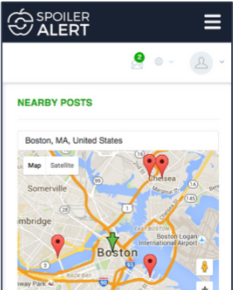With the holidays in full swing, parties, dinners, luncheons and breakfasts with Santa can put the joy in your holidays, but can also lead to food waste heading to landfill. With all the focus of food this season, waste generators have some techy help for food diversion.
The U.S. Environmental Protection Agency estimates that each year billions of pounds of good food go to waste in the U.S. That’s as much as 30 to 40 percent of the food supply.
Additionally, the U.S. Department of Agriculture estimates that 21 percent of the available food in the U.S. goes uneaten at the consumer level. In total, 36 pounds of food per person is wasted each month at the retail and consumer levels. In 2010, an estimated 133 billion pounds of food from U.S. retail food stores, restaurants, and homes went uneaten. The amount of wasted food in homes and restaurants was valued at almost $390 per U.S. consumer in 2008, more than an average month's worth of food expenditures.
A problem so big, in fact, that this year USDA and EPA announced the first-ever national food waste reduction goal, calling for a 50 percent reduction in food waste by 2030. As part of the effort, the federal government is leading a new partnership with charitable organizations, faith-based organizations, the private sector and local, state and tribal governments to reduce food loss and waste in order to improve overall food security and conserve natural resources.
Technology is another tool for these and other organizations to reach food waste producers and help them divert the waste from landfill.
Among the applications to help reduce food waste are:
FoodKeeper, the USDA’s mobile application, offers users valuable storage advice about more than 400 food and
beverage items. Every year, consumers toss billions of pounds of food because of uncertainty of its quality or safety. The app helps consumers understand how different storing methods affect a product’s shelf life. The hope is to help consumers maximize the storage life of foods and beverages in their homes. In addition, the application has an integrated calendar that can remind users when items are likely to spoil. Users can search the application with swipe gestures or voice command. If a user cannot find information about a product, they can submit a question using “Ask Karen,” the app’s virtual USDA representative. The application is available for Android and Apple devices.
FoodCowboy is another app that takes care of large events. Originally founded
by truckers and brothers, Roger and Richard Gordon, who as truckers worked to find food pantries or churches to donate fresh food that was turned down by retailers for appearances, like crooked carrots or too-dark eggplants. Often delivering after hours, they struggled to find organizations open late at night. And food was tossed out. The application lets donors enter information such as food type, temperature, quantity and description so food banks know what they’re receiving. Charities provide logistical information about where and when they can accept food deliveries. Recipients pay Food Cowboy ten cents a pound for donated food, which is a big discount, as typically, non-profits pay between 25 cents to 49 cents a pound for donations.
WasteNoFood is a California-based nonprofit web and mobile marketplace that connects people who have
excess food with the hungry. Founded in 2011 by a seventh grader named Kiran Sridhar who, after learning about the amount of food wasted in the U.S., decided to help resolve the problem using technology to enable restaurants, hotels, convention centers, corporate cafeterias and sports stadiums to donate excess food to charities serving the hungry. There has been no efficient way for groups with excess food to donate to the millions of hungry Californians and Americans. Donors who wish to donate their excess food can sign up and post excess food as it becomes available. Qualified charities in the vicinity of the donors can claim the food. The charities are responsible for transportation and food handling. Levis Stadium, home to the San Francisco 49ers is among those partnering with WasteNoFood to reduce food waste.
Spoiler Alert connects people with excess food with those who need it. The app, founded by MIT Sloan MBA students Emily Malina and Ricky Ashenfelter last year, addresses food waste issues by helping organizations and companies manage their surplus food and organic waste by connecting them with organizations that can use them. For example,
 with the Spoiler Alert app, a store with the surplus vegetables can post what is available, and nearby food rescue organizations can respond and pick up the food in time to provide the still-fresh items to people who could use them. Eight Massachusetts-based food organizations, ranging from retailers, manufacturers, distributors and food-recovery non-profits, including the Greater Boston Food Bank, took part in a recent pilot program, and diverted 10,000 pounds of food in a six week period.
with the Spoiler Alert app, a store with the surplus vegetables can post what is available, and nearby food rescue organizations can respond and pick up the food in time to provide the still-fresh items to people who could use them. Eight Massachusetts-based food organizations, ranging from retailers, manufacturers, distributors and food-recovery non-profits, including the Greater Boston Food Bank, took part in a recent pilot program, and diverted 10,000 pounds of food in a six week period.
About the Author(s)
You May Also Like


